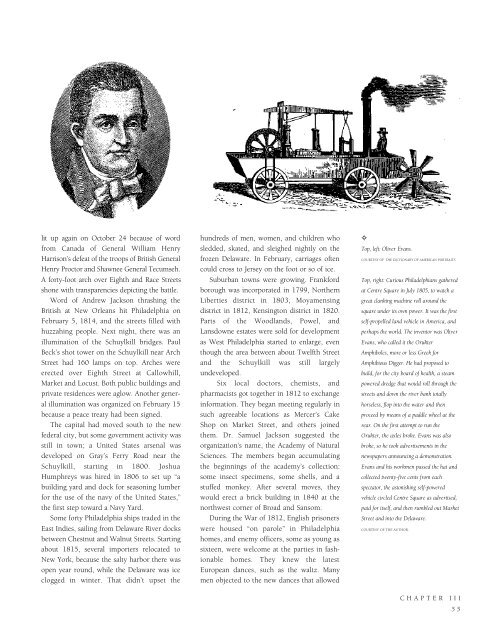Historic Philadelphia
An illustrated history of the city of Philadelphia, paired with the histories of companies, families and organizations that make the region great.
An illustrated history of the city of Philadelphia, paired with the histories of companies, families and organizations that make the region great.
You also want an ePaper? Increase the reach of your titles
YUMPU automatically turns print PDFs into web optimized ePapers that Google loves.
lit up again on October 24 because of word<br />
from Canada of General William Henry<br />
Harrison’s defeat of the troops of British General<br />
Henry Proctor and Shawnee General Tecumseh.<br />
A forty-foot arch over Eighth and Race Streets<br />
shone with transparencies depicting the battle.<br />
Word of Andrew Jackson thrashing the<br />
British at New Orleans hit <strong>Philadelphia</strong> on<br />
February 5, 1814, and the streets filled with<br />
huzzahing people. Next night, there was an<br />
illumination of the Schuylkill bridges. Paul<br />
Beck’s shot tower on the Schuylkill near Arch<br />
Street had 160 lamps on top. Arches were<br />
erected over Eighth Street at Callowhill,<br />
Market and Locust. Both public buildings and<br />
private residences were aglow. Another general<br />
illumination was organized on February 15<br />
because a peace treaty had been signed.<br />
The capital had moved south to the new<br />
federal city, but some government activity was<br />
still in town; a United States arsenal was<br />
developed on Gray’s Ferry Road near the<br />
Schuylkill, starting in 1800. Joshua<br />
Humphreys was hired in 1806 to set up “a<br />
building yard and dock for seasoning lumber<br />
for the use of the navy of the United States,”<br />
the first step toward a Navy Yard.<br />
Some forty <strong>Philadelphia</strong> ships traded in the<br />
East Indies, sailing from Delaware River docks<br />
between Chestnut and Walnut Streets. Starting<br />
about 1815, several importers relocated to<br />
New York, because the salty harbor there was<br />
open year round, while the Delaware was ice<br />
clogged in winter. That didn’t upset the<br />
hundreds of men, women, and children who<br />
sledded, skated, and sleighed nightly on the<br />
frozen Delaware. In February, carriages often<br />
could cross to Jersey on the foot or so of ice.<br />
Suburban towns were growing. Frankford<br />
borough was incorporated in 1799, Northern<br />
Liberties district in 1803, Moyamensing<br />
district in 1812, Kensington district in 1820.<br />
Parts of the Woodlands, Powel, and<br />
Lansdowne estates were sold for development<br />
as West <strong>Philadelphia</strong> started to enlarge, even<br />
though the area between about Twelfth Street<br />
and the Schuylkill was still largely<br />
undeveloped.<br />
Six local doctors, chemists, and<br />
pharmacists got together in 1812 to exchange<br />
information. They began meeting regularly in<br />
such agreeable locations as Mercer’s Cake<br />
Shop on Market Street, and others joined<br />
them. Dr. Samuel Jackson suggested the<br />
organization’s name, the Academy of Natural<br />
Sciences. The members began accumulating<br />
the beginnings of the academy’s collection:<br />
some insect specimens, some shells, and a<br />
stuffed monkey. After several moves, they<br />
would erect a brick building in 1840 at the<br />
northwest corner of Broad and Sansom.<br />
During the War of 1812, English prisoners<br />
were housed “on parole” in <strong>Philadelphia</strong><br />
homes, and enemy officers, some as young as<br />
sixteen, were welcome at the parties in fashionable<br />
homes. They knew the latest<br />
European dances, such as the waltz. Many<br />
men objected to the new dances that allowed<br />
✧<br />
Top, left: Oliver Evans.<br />
COURTESY OF THE DICTIONARY OF AMERICAN PORTRAITS.<br />
Top, right: Curious <strong>Philadelphia</strong>ns gathered<br />
at Centre Square in July 1805, to watch a<br />
great clanking machine roll around the<br />
square under its own power. It was the first<br />
self-propelled land vehicle in America, and<br />
perhaps the world. The inventor was Oliver<br />
Evans, who called it the Orukter<br />
Amphiboles, more or less Greek for<br />
Amphibious Digger. He had proposed to<br />
build, for the city board of health, a steam<br />
powered dredge that would roll through the<br />
streets and down the river bank totally<br />
horseless, flop into the water and then<br />
proceed by means of a paddle wheel at the<br />
rear. On the first attempt to run the<br />
Orukter, the axles broke. Evans was also<br />
broke, so he took advertisements in the<br />
newspapers announcing a demonstration.<br />
Evans and his workmen passed the hat and<br />
collected twenty-five cents from each<br />
spectator, the astonishing self-powered<br />
vehicle circled Centre Square as advertised,<br />
paid for itself, and then rumbled out Market<br />
Street and into the Delaware.<br />
COURTESY OF THE AUTHOR.<br />
CHAPTER III<br />
55
















